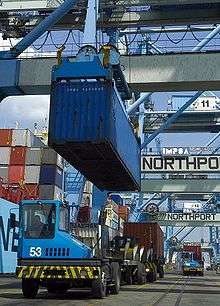Customs and monetary union
| Part of a series on |
| World trade |
|---|
 |
An customs and monetary union is a type of trade bloc which is composed of a customs union and a currency union. The participant countries have both common external trade policy and share a single currency.
Customs and monetary union is established through trade pact.
List of customs and monetary unions
.png)
- Economic and Monetary Union of the European Union (1999/2002) with the Euro for the Eurozone members
- de facto San Marino – European Union[1]
- de facto Andorra – European Union[1]
- de facto Monaco – European Union[1]
- de facto Switzerland–Liechtenstein[2]
- de facto the OECS Eastern Caribbean Currency Union with the East Caribbean dollar in the CSME (2006)[3]
- Economic and Monetary Community of Central Africa (CEMAC)[4]
- West African Economic and Monetary Union (UEMOA)[5]
- de facto the Common Monetary Area (CMA) in the Southern Africa Customs Union (SACU)
Note: Every economic and monetary union has also a customs and monetary union.
Additionally the autonomous and dependent territories, such as some of the EU member state special territories, are sometimes treated as separate customs territory from their mainland state or have varying arrangements of formal or de facto customs union, common market and currency union (or combinations thereof) with the mainland and in regards to third countries through the trade pacts signed by the mainland state.[6]
Proposed
- 2012 East African Community (EAC)
- 2018 Common Market for Eastern and Southern Africa (COMESA)
- Economic Community of Central African States (ECCAS)[7]
- Economic Community of West African States (ECOWAS)[8]
- Gulf Cooperation Council
Notes
- 1 2 3 Within the EU customs area and has a monetary agreement with the EU.
- ↑ Customs union since 1924, informal currency union since 1920.
- ↑ The states participating in both initiatives are Antigua and Barbuda, Dominica, Grenada, Saint Kitts and Nevis, Saint Lucia, Saint Vincent and the Grenadines.
- ↑ Enforced since 1999-6-24 WT/COMTD/N/13
- ↑ Enforced since 2000-1-1 WT/COMTD/N/11/Add.1
- ↑ EU Overseas countries and some other territories participate partially in the EU single market per part four of the Treaty Establishing the European Community; Some EU Outermost regions and other territories use the Euro of the currency union, others are part of the customs union; some participate in both unions and some in neither.
Territories of the United States, Australian External Territories and Realm of New Zealand territories share the currency and mostly also the market of their respective mainland state, but are generally not part of its customs territory. - ↑ Extension of CEMAC to the rest of the ECCAS members.
- ↑ Extension of UEMOA customs union to the rest of the ECOWAS members and merger with the WAMZ.
Further reading
- Bergin, Paul (2008). "Monetary Union". In David R. Henderson (ed.). Concise Encyclopedia of Economics (2nd ed.). Indianapolis: Library of Economics and Liberty. ISBN 978-0865976658. OCLC 237794267.
